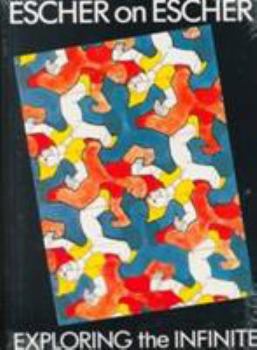Escher on Escher
Select Format
Select Condition 
Book Overview
Presents a selection of Escher's art and shares his comments on his work, symmetry, infinity, and paradox.
Format:Paperback
Language:English
ISBN:0810924145
ISBN13:9780810924147
Release Date:March 1989
Publisher:Harry N. Abrams
Length:158 Pages
Weight:0.82 lbs.
Dimensions:0.5" x 6.1" x 8.4"
Age Range:13 years and up
Grade Range:Grade 8 to Postsecondary
Customer Reviews
2 ratings
"I'm walking around all by myself here."..Escher
Published by Thriftbooks.com User , 16 years ago
As a longtime fan of Escher's work,I found this an excellent book.I have several books of Escher's work,a couple of jigsaw puzzles,and his "Kaleidocycles" of 17 full-color ,three dimensional ,folding models.This book is very interesting to any fan of Escher's work as it is Escher himself explaining his reasons for creating his art. For a long time, he was virtually alone in his field, that combines both graphic art and Geometric Mathematics. Reading the book is as close as one can get to attending lectures by the master himself. Escher prepared lectures that were accompanied with slides of his work that he intended to give to explain his work. The book contains the complete text of these lectures as well as pictures of the slides and his explanations. The book shows what great difficulty he had in gaining acceptance of his work ,which critics had great difficulty in catgorizing his work and thus tended to ignore it for many years. While the reproductions in this book are small,as other reviewers have mentioned,don't let that discourage you from getting this book.There are other books with much larger reproductions that show off his work much better.But, if you want to get a much deeper knowledge of this wonderful artist and understand his motives and life;you would have a hard time in finding a better sourse to turn to.
Escher in his own words
Published by Thriftbooks.com User , 20 years ago
Maurits Escher, as an artist, needs no introduction. As a writer, however, he is not nearly well known enough. This short book collects some of his early writings from rather obscure journals, and presents a lecture that was never actually given. Escher is well known for his precise renderings, and we are blessed with writing in the same precise style. He wrote out the script for his lecture in full, before it was to be given. That means that, when a medical emergency forced its cancellation, the lecture was preserved in its entirety. Like his geometric woodcuts and his precise lithographs, the calm of the text belies the passion that lay behind it. Escher spent decades in poverty before his well-earned fame, and pursued visions for which he had no good words and certainly no companions. That same drive was what pushed his skill as a woodblock artist down to the limits of his hands and his materials, below the limit of his unaided eye. Although not trained in math or the hard sciences, he puts a human face on subtle mathematical concepts. The infinite and unbounded is a common idea, the finite and bounded is part of everyday life. These aren't his words, but he pursued the finite and unbounded, in tiled patterns on the surface of a sphere. He also sought out the infinite and bounded, and found it in the Cirle Limit pieces and other works. This book is the only inexpensive and easily accesible source of Escher's own thoughts on his work. It's not a catalog of his work - most of the reproductions so small that they only suggest the piece depicted, or remind a viewer already familiar with the work. It's not a biography, although it has a few biographical details. People with the wrong expectations are sure to be disappointed in this. I'm happy with it. It is a very enjoyable look at his cool manner of presentation. Like his Three Worlds litho, it presents a surface of meaning, but shows reflections of distant ideas and hints at his hidden depths. //wiredweird






